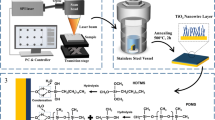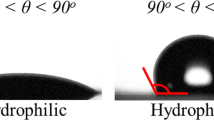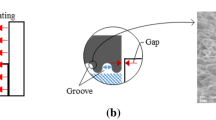Abstract
An easy-to-implement method by which to fabricate superhydrophobic surfaces inspired taro leaf was successfully applied on 316L stainless steel via combining nanosecond laser (NL) processing and spin-coating techniques. The laser-textured surface composed of microscale frameworks and central bumps was fabricated by NL processing based on properly designed biomimetic patterns, and a layer of nanoscale carbon black/polydimethylsiloxane (CB/PDMS) particles was covered on it by spin-coating. The effect of pattern parameters (i.e., the inscribed circle radius of framework and the radius of central bump) on wettability of biomimetic surface was investigated. All as-prepared biomimetic surfaces with micro-nano hierarchical structures showed excellent superhydrophobicity with the water contact angle of ∼155° and contact angle hysteresis of ∼2°. By comparing the untreated surface, the wetting behavior and evaporation mode of the biomimetic surface occurred an obvious transformation. Meanwhile, experiments indicated that the biomimetic surface not only had liquid-repelling and self-cleaning functions, but also maintained remarkable mechanical robustness and superhydrophobic durability. The method is efficient for fabricating biomimetic superhydrophobic surfaces applied to liquid-repelling, evaporation-transforming and self-cleaning fields.
Similar content being viewed by others
References
Drelich J, Chibowski E, Meng D D, et al. Hydrophilic and superhydrophilic surfaces and materials. Soft Matter, 2011, 7: 9804–9828
Ta V D, Dunn A, Wasley T J, et al. Laser textured superhydrophobic surfaces and their applications for homogeneous spot deposition. Appl Surf Sci, 2016, 365: 153–159
Wang H, Liu C, Zhan H, et al. Droplet asymmetric bouncing on inclined superhydrophobic surfaces. ACS Omega, 2019, 4: 12238–12243
Liu Y, Li S, Zhang J, et al. Corrosion inhibition of biomimetic superhydrophobic electrodeposition coatings on copper substrate. Corrosion Sci, 2015, 94: 190–196
Cao Y, Zheng D, Li X, et al. Enhanced corrosion resistance of superhydrophobic layered double hydroxide films with long-term stability on Al substrate. ACS Appl Mater Interfaces, 2018, 10: 15150–15162
Barthwal S, Lim S H. Rapid fabrication of a dual-scale micro-nanostructured superhydrophobic aluminum surface with delayed condensation and ice formation properties. Soft Matter, 2019, 15: 7945–7955
Pan Q, Cao Y, Xue W, et al. Picosecond laser-textured stainless steel superhydrophobic surface with an antibacterial adhesion property. Langmuir, 2019, 35: 11414–11421
Mei X, Lu L, Xie Y, et al. Preparation of flexible carbon fiber fabrics with adjustable surface wettability for high-efficiency electromagnetic interference shielding. ACS Appl Mater Interfaces, 2020, 12: 49030–49041
Barthlott W, Neinhuis C. Purity of the sacred lotus, or escape from contamination in biological surfaces. Planta, 1997, 202: 1–8
Wang P, Zhao T, Bian R, et al. Robust superhydrophobic carbon nanotube film with lotus leaf mimetic multiscale hierarchical structures. ACS Nano, 2017, 11: 12385–12391
Zhao Y, Yu C, Lan H, et al. Improved interfacial floatability of superhydrophobic/superhydrophilic janus sheet inspired by lotus leaf. Adv Funct Mater, 2017, 27: 1701466
Feng L, Li S, Li Y, et al. Super-hydrophobic surfaces: From natural to artificial. Adv Mater, 2002, 14: 1857–1860
Song M, Hu D, Zheng X, et al. Enhancing droplet deposition on wired and curved superhydrophobic leaves. ACS Nano, 2019, 13: 7966–7974
Fang Y, Yong J, Chen F, et al. Bioinspired fabrication of Bi/tridirectionally anisotropic sliding superhydrophobic pdms surfaces by femtosecond laser. Adv Mater Interfaces, 2018, 5: 1701245
Chang L, Wang T, Kong J, et al. Biomimetic fabrication of indicalamus-leaf-like structured copper surface with superhydrophobic properties. Materials Transactions, 2013, 54: M2013224
Wang T, Chen K, Sun X, et al. Preparation of a super-hydrophobic zinc coating with a hierarchical structure inherited from the indicalamus leaf through electroplating. Adv Mater Interfaces, 2018, 5: 1701327
Tran N G, Chun D M. Simple and fast surface modification of nanosecond-pulse laser-textured stainless steel for robust superhydrophobic surfaces. CIRP Ann, 2020, 69: 525–528
Lian Z, Xu J, Yu Z, et al. Bioinspired reversible switch between underwater superoleophobicity/superaerophobicity and oleophilicity/aerophilicity and improved antireflective property on the nanosecond laser-ablated superhydrophobic titanium surfaces. ACS Appl Mater Interfaces, 2020, 12: 6573–6580
Trdan U, Hočevar M, Gregorčič P. Transition from superhydrophilic to superhydrophobic state of laser textured stainless steel surface and its effect on corrosion resistance. Corrosion Sci, 2017, 123: 21–26
Lu L, Yao W, Xie Y, et al. Study on the wettability of biomimetic stainless-steel surfaces inspired by Bauhinia Linn. leaf. Surf Coat Technol, 2021, 405: 126721
Wan Y, Xi C, Yu H. Fabrication of self-cleaning superhydrophobic surface on stainless steel by nanosecond laser. Mater Res Express, 2018, 5: 115002
Lian Z, Xu J, Yu Z, et al. A simple two-step approach for the fabrication of bio-inspired superhydrophobic and anisotropic wetting surfaces having corrosion resistance. J Alloys Compd, 2019, 793: 326–335
Dong S, Wang Z, Wang Y, et al. Roll-to-roll manufacturing of robust superhydrophobic coating on metallic engineering materials. ACS Appl Mater Interfaces, 2018, 10: 2174–2184
Gao S, Dong X, Huang J, et al. Rational construction of highly transparent superhydrophobic coatings based on a non-particle, fluorine-free and water-rich system for versatile oil-water separation. Chem Eng J, 2018, 333: 621–629
Ge M, Cao C, Liang F, et al. A “PDMS-in-water” emulsion enables mechanochemically robust superhydrophobic surfaces with self-healing nature. Nanoscale Horiz, 2020, 5: 65–73
Pan R, Cai M, Liu W, et al. Extremely high Cassie-Baxter state stability of superhydrophobic surfaces via precisely tunable dual-scale and triple-scale micro-nano structures. J Mater Chem A, 2019, 7: 18050–18062
Li K, Yao W, Xie Y, et al. A strongly hydrophobic and serum-repelling surface composed of CrN films deposited on laser-patterned microstructures that was optimized with an orthogonal experiment. Surf Coatings Tech, 2020, 391: 125708
Hu Y, Zhao B, Lin S, et al. Evaporation and particle deposition of bicomponent colloidal droplets on a superhydrophobic surface. Int J Heat Mass Transfer, 2020, 159: 120063
Teisala H, Butt H J. Hierarchical structures for superhydrophobic and superoleophobic surfaces. Langmuir, 2019, 35: 10689–10703
Koch K, Bhushan B, Barthlott W. Multifunctional surface structures of plants: An inspiration for biomimetics. Prog Mater Sci, 2009, 54: 137–178
Cassie A B D, Baxter S. Wettability of porous surfaces. Trans Faraday Soc, 1944, 40: 546–551
Whyman G, Bormashenko E, Stein T. The rigorous derivation of Young, Cassie-Baxter and Wenzel equations and the analysis of the contact angle hysteresis phenomenon. Chem Phys Lett, 2008, 450: 355–359
Ma J, Sun Y, Gleichauf K, et al. Nanostructure on taro leaves resists fouling by colloids and bacteria under submerged conditions. Langmuir, 2011, 27: 10035–10040
Liu R, Chi Z, Cao L, et al. Fabrication of biomimetic superhydrophobic and anti-icing Ti6Al4V alloy surfaces by direct laser interference lithography and hydrothermal treatment. Appl Surf Sci, 2020, 534: 147576
Sun J, Wang W, Liu Z, et al. Study on selective laser melting 316L stainless steel parts with superhydrophobic surface. Appl Surf Sci, 2020, 533: 147445
Li S, Liu Y, Zheng Z, et al. Biomimetic robust superhydrophobic stainless-steel surfaces with antimicrobial activity and molecular dynamics simulation. Chem Eng J, 2019, 372: 852–861
Blossey R. Self-cleaning surfaces—virtual realities. Nat Mater, 2003, 2: 301–306
Liu Y, Yan X, Wang Z. Droplet dynamics on slippery surfaces: Small droplet, big impact. Biosurf Biotri, 2019, 5: 35–45
Liang L, Lu L, Xing D, et al. Preparation of superhydrophobic and anti-resin-adhesive surfaces with micro nanoscale structures on high-speed steel via laser processing. Surf Coatings Tech, 2019, 357: 57–68
He A, Liu W, Xue W, et al. Nanosecond laser ablated copper super-hydrophobic surface with tunable ultrahigh adhesion and its renew-ability with low temperature annealing. Appl Surf Sci, 2018, 434: 120–125
Jagdheesh R, Diaz M, Marimuthu S, et al. Hybrid laser and vacuum process for rapid ultrahydrophobic Ti-6Al-4V surface formation. Appl Surf Sci, 2019, 471: 759–766
Liu Y, Chen J, Guo D, et al. Floatable, self-cleaning, and carbon-black-based superhydrophobic gauze for the solar evaporation enhancement at the air-water interface. ACS Appl Mater Interfaces, 2015, 7: 13645–13652
Wenzel R N. Resistance of solid surfaces to wetting by water. Ind Eng Chem, 1936, 28: 988–994
Fu P, Shi X, Jiang F, et al. Superhydrophobic nanostructured copper substrate as sensitive SERS platform prepared by femtosecond laser pulses. Appl Surf Sci, 2020, 501: 144269
Jia B, Wang F, Chan H, et al. In situ printing of liquid superlenses for subdiffraction-limited color imaging of nanobiostructures in nature. Microsyst Nanoeng, 2019, 5: 1
Schönfeld F, Graf K H, Hardt S, et al. Evaporation dynamics of sessile liquid drops in still air with constant contact radius. Int J Heat Mass Transfer, 2008, 51: 3696–3699
Erbil H Y. Evaporation of pure liquid sessile and spherical suspended drops: A review. Adv Colloid Interface Sci, 2012, 170: 67–86
Antonini C, Villa F, Marengo M. Oblique impacts of water drops onto hydrophobic and superhydrophobic surfaces: Outcomes, timing, and rebound maps. Exp Fluids, 2014, 55: 1713
Kim W, Eun J, Jeon S. Anti-splashing properties of sticky super-hydrophobic surfaces. Appl Surf Sci, 2021, 542: 148617
Lu Y, Sathasivam S, Song J, et al. Robust self-cleaning surfaces that function when exposed to either air or oil. Science, 2015, 347: 1132–1135
Lin Y, Zhou R, Xu J. Superhydrophobic surfaces based on fractal and hierarchical microstructures using two-photon polymerization: Toward flexible superhydrophobic films. Adv Mater Interfaces, 2018, 5: 1801126
Chen T L, Huang C Y, Xie Y T, et al. Bioinspired durable superhydrophobic surface from a hierarchically wrinkled nanoporous polymer. ACS Appl Mater Interfaces, 2019, 11: 40875–40885
Author information
Authors and Affiliations
Corresponding author
Additional information
This work was supported by the National Key Research and Development Program of China (Grant No. 2019YFE0126300), the National Natural Science Foundation of China (Grant No. 51775197), and the Natural Science Foundation of Guangdong Province (Grant No. 2019A1515011530).
Supporting Information
Supplementary material, approximately 1.38 MB.
Supplementary material, approximately 251 KB.
Supplementary material, approximately 1.22 MB.
Rights and permissions
About this article
Cite this article
Li, K., Lei, J., Xie, Y. et al. An easy-to-implement method for fabricating superhydrophobic surfaces inspired by taro leaf. Sci. China Technol. Sci. 64, 2676–2687 (2021). https://doi.org/10.1007/s11431-021-1855-2
Received:
Accepted:
Published:
Issue Date:
DOI: https://doi.org/10.1007/s11431-021-1855-2




